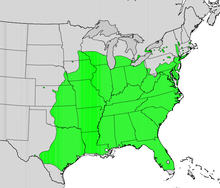Red mulberry
| Morus rubra | |
|---|---|
 |
|
| 1809 illustration | |
| Scientific classification | |
| Kingdom: | Plantae |
| (unranked): | Angiosperms |
| (unranked): | Eudicots |
| (unranked): | Rosids |
| Order: | Rosales |
| Family: | Moraceae |
| Genus: | Morus |
| Species: | M. rubra |
| Binomial name | |
|
Morus rubra L. 1753 |
|
 |
|
| Native range | |
Morus rubra, commonly known as the red mulberry, is a species of mulberry native to eastern and central North America. It is found from Ontario, Minnesota, and Vermont south to southern Florida, and west as far as southeastern South Dakota, Nebraska, Kansas, and central Texas. There have been reports of isolated populations (very likely naturalized) in New Mexico, Idaho, and British Columbia.
Common in the United States, it is listed as an endangered species in Canada, and is susceptible to hybridization with the invasive white mulberry (M. alba), introduced from Asia.
Red mulberry is a deciduous tree, growing to 10–15 m (35–50 ft) tall, rarely 20 m (65 ft), with a trunk up to 50 cm (20 in) in diameter. It is a small to medium-sized tree that reaches a height of 70 feet and lives up to 125 years. The leaves are alternate, 7–14 cm (2 3⁄4–5 1⁄2 in) long and 6–12 cm (2 1⁄4–4 3⁄4 in) broad, simple, broadly cordate, with a shallow notch at the base, typically unlobed on mature trees although often with 2-3 lobes, particularly on young trees, and with a finely serrated margin. The upper surface of the leaves is noticeably rough, similar in texture to fine sandpaper, and unlike the lustrous upper surface of the leaves of white mulberry (M. alba). The underside of the leaves is covered with soft hairs. The leaf petiole exudes milky sap when severed. Red mulberry is hardy to subzero temperatures, relatively hardy to drought, pollution, and poor soil, though the white mulberry is hardier.
...
Wikipedia
